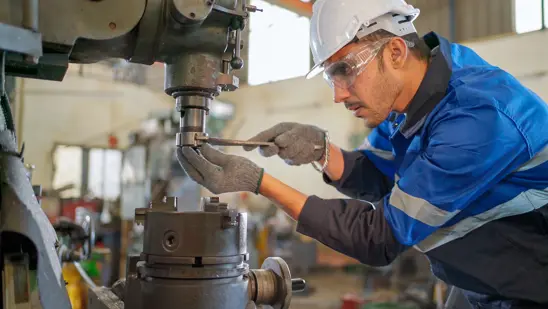The Value: Owning Aftermarket Service Drives More Than Just Revenue

Aftermarket Parts and Service: Where the Real Money in Manufacturing is Made

“Merchandising! Merchandising! Where the real money from the movie is made.”
If you recognize which movie this quote is from, you are my people.
If you don’t, stop reading this blog and watch the cult classic Mel Brooks film Spaceballs. Right now.
If you haven’t seen it, and you don’t want to (your choice, but your loss), Spaceballs is a parody of the original Star Wars movie trilogy. That quote is delivered by Yogurt, the Spaceballs version of Yoda.
Yogurt’s line perfectly sums up one of the movie’s big running gags: everything can be branded, and everything can be sold. Even Spaceballs: The Flamethrower (“The kids love this one!”). And when a movie is wildly popular, those branding stakes get even higher.
Just look at the franchise Spaceballs spoofed – the commercialization of Star Wars is basically an industry of its own.
But there’s a reason a wise leader like Yogurt would cash in on merchandising, and why movie studios do too: it’s profitable.
So what does this have to do with manufacturing?
Aftermarket Parts and Service: Turning One-Time Purchases into Long-Running Profits
The magic of merchandising is that it transforms a fleeting, one-and-done transaction into an ongoing money-maker. For movies, the core sale is that ticket or streaming rental – a few bucks per seat. But when that same fan walks out of the theater and buys the T-shirt, the Lego set, or yes, the flamethrower, the studio keeps cashing in long after the credits roll.
Manufacturers follow the same play: aftermarket parts and service offerings transform one-off transactions into recurring revenue streams. The upfront sale might be a million-dollar piece of equipment. But the steady flow of replacement parts, service calls, and upgrades keep the machine – and the revenue – humming for years. According to McKinsey, the “margins for providing aftermarket services are almost always at least double the margins on sales of new units.”
Take Rolls Royce, for example.
According to Aviation Week Network, civil aerospace makes up about half of the company’s total sales — and within that division, the aftermarket is the real powerhouse.
In 2023, services revenue jumped by a quarter to £4.6 billion ($5.8 billion), accounting for 63% of Rolls-Royce’s civil aerospace revenue, up from about 54% a decade ago. To put it in perspective: roughly £3.3 billion ($4.2 billion) of that came from servicing their large engines, while the original equipment sales for those same engines brought in just £2 billion ($2.5 billion). The math is clear: the real profit lies in keeping the engine flying, not just in selling it once.

Unlike consumer gadgets that are swapped out every few years, industrial equipment sticks around. The average age of industrial/manufacturing machinery in use in the U.S. is close to 20 years, according to the U.S. Bureau of Economic Analysis (BEA). Zoom in on one vertical – food processing – and the average age jumps to 24 years.
It makes sense: industrial equipment is a significant capital expense. For companies feeling the pressure of tariffs, economic uncertainty, and tight labor markets, it’s no surprise that they hesitate to shell out for brand-new machines – especially if their existing ones still get the job done.
So instead of plunking down a huge cash outlay for a full equipment replacement, companies protect their investment with far less capital-intensive maintenance – strategically replacing and rebuilding parts and pieces where needed. But those parts and that labor have to come from somewhere.
For manufacturers looking for not only stable, reliable revenue but also a channel that delivers critical customer and competitive intelligence, that somewhere should absolutely be them.
- 1
Asset Lifecycle Control
When you own the service relationship, you control how your equipment performs from day one to its final rebuild or retirement. No one knows how to maintain and upgrade your machines better than you do, so why let someone else profit from that expertise?
- 2
Digital Thread Visibility
Every piece of service data feeds back into your understanding of how your products run in the real world. With sensors and IoT tools, you can monitor performance, spot problems before they happen, and design better products — all thanks to insights you’d never get from a third-party service middleman.
- 3
Direct Customer Relationships
Many manufacturers sell through dealer and distributor channels, which can blur the connection with the end user. By owning the service relationship directly, you gain firsthand knowledge of customer needs, usage patterns, and pain points. This information can in turn translate to valuable opportunities that the traditional channel model can often hide.
- 4
Competitive Equipment Insights
Owning the service channel gives you clear line-of-sight into what’s happening in your customer’s shop or plant, including when a competitor’s equipment shows up. That intel helps you win future sales, upgrade older machines, and stay one step ahead of the competition.
- 5
Customer Ecosystem Stickiness
When customers rely on you for parts, service, and upgrades, you’re creating an ecosystem that’s tough to walk away from. That’s brand stickiness at its best: the more value you deliver after the sale, the harder it is for competitors to pry your customers away.
- 6
Data-Driven Service Innovation
Once you’re connected to your equipment in the field, you’re ready to take the next leap: product as a service. In a product-as-a-service model, customers don’t just buy a machine — they buy guaranteed uptime, predictable costs, and performance as a subscription. They get reliable operations; you get reliable, high-margin revenue.
The Flip Side: Challenges of Building a Service Organization
Owning your aftermarket service business isn’t as simple as flipping a switch — if it were, everyone would do it. Here are a few common roadblocks:
Build vs. Buy Decisions
Do you build a service arm from scratch, or buy an existing dealer network or service group? Each option has trade-offs: building takes time and investment, while buying means integrating new people, systems, and processes that weren’t designed with your products in mind. Get it wrong, and you risk a service experience that’s anything but seamless.
Tools and Technology Gaps
Service doesn’t run on good intentions alone — you need the right tools. That means diagnostic systems, parts inventory management, scheduling, and mobile apps that your teams actually use. Without them, you frustrate both your people and your customers.
Install Base Mastery
You can’t service what you can’t see. Many manufacturers struggle to even know where all their machines are, what condition they’re in, or which parts they use. Mastering your install base — tracking it, analyzing it, and acting on that data — is essential if you want to capture the full service value.
Skilled Talent Shortage
Last but definitely not least: people. Building a service business means finding, training, and keeping technicians, parts managers, and support staff (all in an industry where skilled labor is getting harder to find). Without the right people, even the best strategy will stall out.
The Bottom Line
In the end, Yogurt had it right: the real money isn’t in the one-time sale — it’s in everything that comes after. For manufacturers, that means building an aftermarket service business that keeps customers happy, equipment running, and margins healthy long after the initial handshake.
Is it easy? Not at all. But the manufacturers who nail it aren’t just selling machines — they’re selling trust and long-term value that competitors can’t easily rip away. And getting it right takes the right technology and the right expertise.
That’s where HSO comes in. As a leading Microsoft partner, we know manufacturing, and we know how to help you modernize your service operations with the right tools and data.
So maybe it’s time to take a page out of Hollywood’s playbook — and Yogurt’s too — and turn your service business into your next blockbuster.





